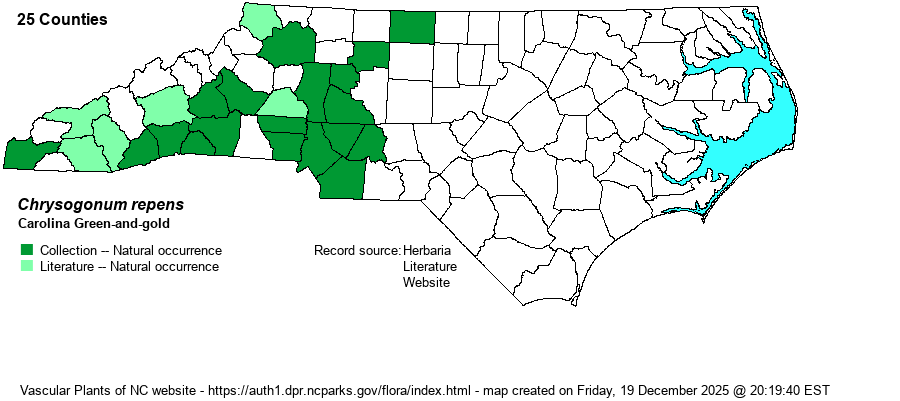| Author | (Cassini) Nesom | |
| Distribution | Middle and upper Piedmont and the southern Mountains. Our map is taken directly from the papers by Nesom in Sida 19: 811-820, and Phytoneuron 2020-94. Whether this truly represents the actual range in the state is uncertain, considering its recent split from the much more common and widespread C. virginianum. See Taxonomic Comments below.
South-central VA and KY, south to central GA and central AL. | |
| Abundance | Uncommon to perhaps common Based on specimens and iNaturalist records. It appears to be fairly common to common in the western Piedmont, but uncommon in the southern half of the Mountains, and very rare northward in the Mountains. The website editors have suggested a State Rank of S4?. | |
| Habitat | Mesic to dry, deciduous and pine-deciduous forests and woodlands, rocky slopes. | |
| Phenology | Flowering and fruiting late March-early June. Green-and-gold (the two species) is one of our handsomest flowers and has one of the longest flowering periods among our spring flora. | |
| Identification | Plants form patches, the individuals connected via surficial stolons (runners). Stems are short, 1.5 feet or less, with ovate leaf blades on long stalks, the leaves crowded near the ground and a rich green color. Heads have bright yellow rays 10-15 mm long and yellow disk florets. From C. virginianum, it is told by the presence of stolons (vs. plants occurring individually). | |
| Taxonomic Comments | NC records were formerly determined as C. virginianum var. australe, but according to Nesom (2001) that is restricted to the Gulf Coastal Plain. Nesom (2001) provided a new name for stoloniferous plants: C. virginianum var. brevistolon; and in 2020 (article in Phytoneuron) raised it to species level as C. repens.
| |
| Other Common Name(s) | Green-and-gold | |
| State Rank | [S4?] | |
| Global Rank | G5TNR | |
| State Status | | |
| US Status | | |
| USACE-agcp | | |
| USACE-emp | | |

